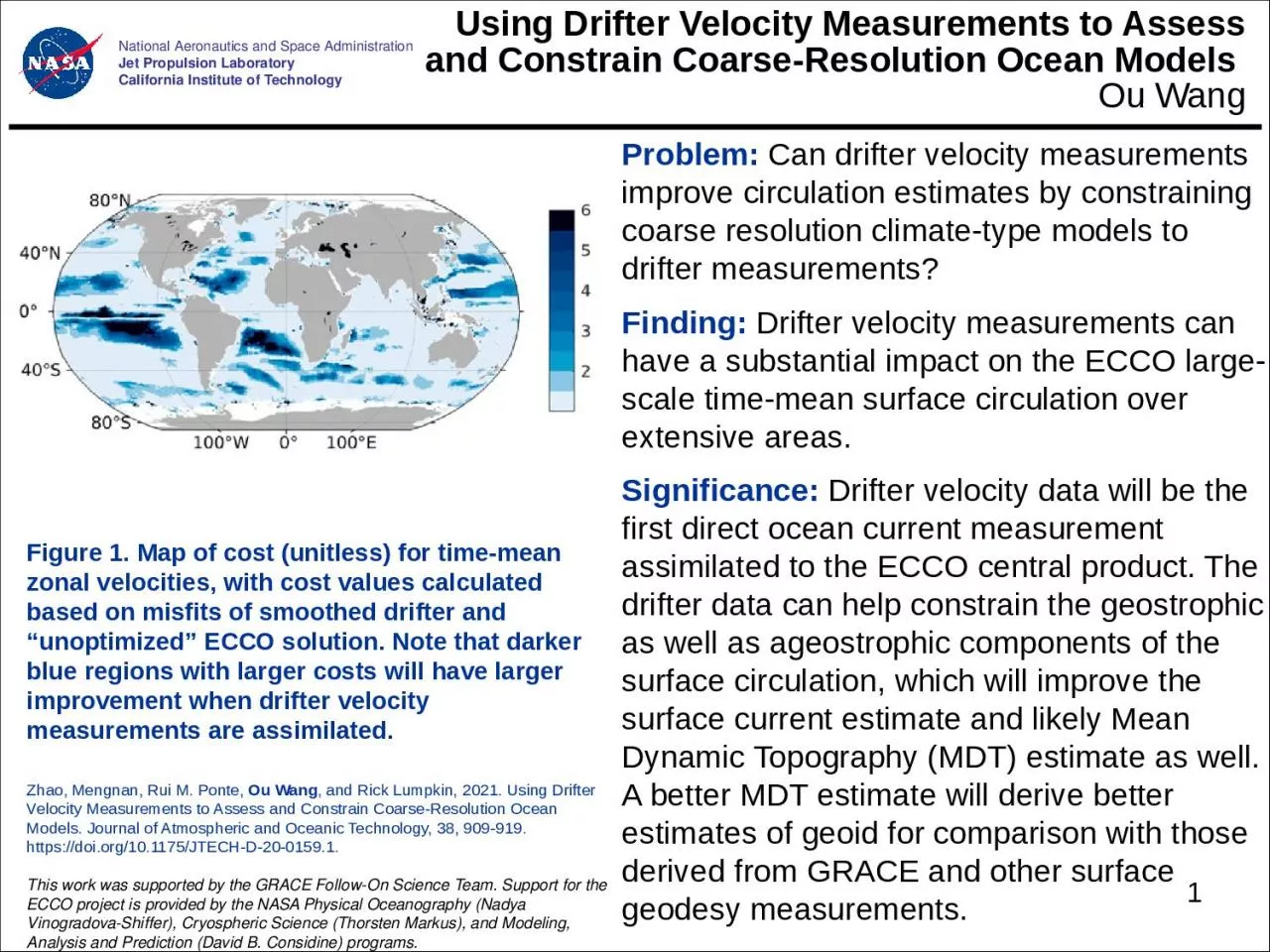

Ou Wang Problem Can drifter velocity measurements improve circulation estimates by constraining coarse resolution climatetype models to drifter measurements Finding Drifter velocity measurements can have a substantial impact on the ECCO largescale timemean surface circulation over exte ID: 1022149
Download Presentation The PPT/PDF document "Using Drifter Velocity Measurements to A..." is the property of its rightful owner. Permission is granted to download and print the materials on this web site for personal, non-commercial use only, and to display it on your personal computer provided you do not modify the materials and that you retain all copyright notices contained in the materials. By downloading content from our website, you accept the terms of this agreement.
1. Using Drifter Velocity Measurements to Assess and Constrain Coarse-Resolution Ocean Models Ou WangProblem: Can drifter velocity measurements improve circulation estimates by constraining coarse resolution climate-type models to drifter measurements?Finding: Drifter velocity measurements can have a substantial impact on the ECCO large-scale time-mean surface circulation over extensive areas.Significance: Drifter velocity data will be the first direct ocean current measurement assimilated to the ECCO central product. The drifter data can help constrain the geostrophic as well as ageostrophic components of the surface circulation, which will improve the surface current estimate and likely Mean Dynamic Topography (MDT) estimate as well. A better MDT estimate will derive better estimates of geoid for comparison with those derived from GRACE and other surface geodesy measurements. Zhao, Mengnan, Rui M. Ponte, Ou Wang, and Rick Lumpkin, 2021. Using Drifter Velocity Measurements to Assess and Constrain Coarse-Resolution Ocean Models. Journal of Atmospheric and Oceanic Technology, 38, 909-919. https://doi.org/10.1175/JTECH-D-20-0159.1.This work was supported by the GRACE Follow-On Science Team. Support for the ECCO project is provided by the NASA Physical Oceanography (Nadya Vinogradova-Shiffer), Cryospheric Science (Thorsten Markus), and Modeling, Analysis and Prediction (David B. Considine) programs. Figure 1. Map of cost (unitless) for time-mean zonal velocities, with cost values calculated based on misfits of smoothed drifter and “unoptimized” ECCO solution. Note that darker blue regions with larger costs will have larger improvement when drifter velocity measurements are assimilated. National Aeronautics and Space AdministrationJet Propulsion LaboratoryCalifornia Institute of Technology
2. National Aeronautics and Space AdministrationJet Propulsion LaboratoryCalifornia Institute of TechnologyContact: Ou Wang, M/S 300-323, Jet Propulsion Laboratory, Pasadena, CA 91109. Ou.Wang@jpl.nasa.govPaper lead author: Mengnan Zhao (MZhao@aer.com).Citation: Zhao, Mengnan, Rui M. Ponte, Ou Wang, and Rick Lumpkin, 2021. Using Drifter Velocity Measurements to Assess and Constrain Coarse-Resolution Ocean Models. Journal of Atmospheric and Oceanic Technology, 38, 909-919. https://doi.org/10.1175/JTECH-D-20-0159.1.Data Sources: The surface drifter velocity measurements are from the Global Drifter Program (GDP) and Ocean Surface Current Analyses Real-Time(OSCAR) velocity data. Drifter velocity data are available at ftp://ftp.aoml.noaa.gov/phod/pub/lumpkin/mengnan. Error estimates are openlyavailable at ftp://ftp.aoml.noaa.gov/phod/pub/lumpkin/drifter_climatology. The OSCAR product can be downloaded from the NASA Physical Oceanography Data Center at https://podaac.jpl.nasa.gov/dataset/OSCAR_L4_OC_third-deg. Velocity data at second vertical level (15-m) from the ECCO control run are available at https://ecco.jpl.nasa.gov/drive/files/Version4/Release4/other/control_run.Technical Description of Figure:Maps of cost (unitless) for time-mean zonal velocities, with cost values calculated based on misfits of smoothed drifter and “unoptimized” ECCO solution. The “unoptimized” ECCO solution is the so-called “control” run which is an initial run of the ocean model without any data constraints.Note that any regions with cost larger than one are where the difference between data and the “unoptimized” control run is larger than the estimated uncertainty. Model time-mean velocity estimate in these regions will benefit from assimilating the drifter velocity data. The darker blue regions where values are larger are in the tropics as well as in some subtropical basin interiors. These regions will have larger improvement when drifter velocity measurements are assimilated into the ECCO solution.Scientific significance, societal relevance, and relationships to future missions: The drifter velocity data will be the first direct ocean current measurement assimilated to the ECCO central product. Information in the drifter data can help constrain the geostrophic as well as ageostrophic components of the surface circulation. Including drifter velocity data will further improve the surface current estimate and likely improve Mean Dynamic Topography (MDT) estimate as well. A better MDT estimate will derive better estimates of geoid for comparison with those derived from GRACE and other surface geodesy measurements. Assimilating of the drifter velocity data can also lead to more realistic boundary forcing and subgrid-scale physical parameterizations. Using Drifter Velocity Measurements to Assess and Constrain Coarse-Resolution Ocean Models Ou Wang